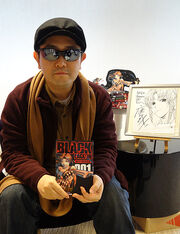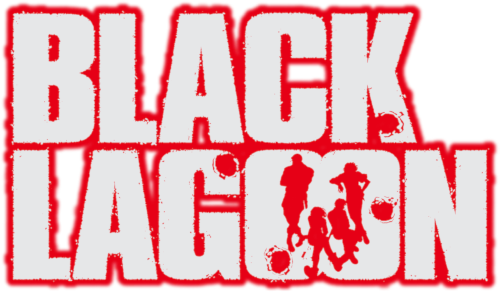
Rei Hiroe
Rei Hiroe (広江 礼威 Hiroe Rei), born 5 December 1972,[1] is a Japanese manga artist who is mostly known for his popular manga Black Lagoon. When he is working on doujin comics he goes by the name Tex-Mex. Hiroe's manga were originally published by Kadokawa Shoten in the 1990s but none were complete. As a response, Hiroe transferred to Shogakukan in the early 2000s, where all of his manga released before Black Lagoon were republished and re-released.
Influences and style[]
In various interviews, Hiroe stated that the idea of Black Lagoon came from doing research on medieval pirates as well as learning about the rise in piracy in the early 1900s in the East China Sea. He figured that he could make a modern story about such pirates and do something Tarantino-esque.[2] He is a fan of the Wild 7 manga by Mikiya Mochizuki, and he additionally enjoys the works of Kenichi Sonoda, a manga artist famous for the manga series Gunsmith Cats.[3] Hiroe has also enlisted the help of Seiichi Shirato and Jugo Tsukuda for technical advice.[4]
Hiroe has stated that he reads books on anything that catches his attention, adding that he prefers the original source over the internet but will use the latter if needed.[4] For gun designs, he has remarked that the guns are not original designs with the exception of Roberta's tommygun in "El Baile de la muerte."[2] In addition to Quentin Tarantino films, Hiroe has been influenced by the Hong Kong triad films of the 1980s and 1990s such as films involving the work of John Woo and Chow Yun-fat.[5] Hiroe does not like the moe style seen in anime and manga, stating that he enjoys making robust women instead of cutesy characters who are attracted to the main character.[2]
Black Lagoon characters and story[]
Regarding the reason that Black Lagoon takes place in 1995, Hiroe has stated:
"When I started [Black Lagoon], I thought we were entering a new era after the end of the Cold War. Of course, that new era brought new problems, but I thought those problems would help shape the new order. By having it take place in 1995, I wanted to show a volatile era of chaos. To create characters who could only live in chaos and will eventually be eliminated as the world becomes more organized. But it turns out that the real world is so chaotic—there is no order. It's one chaotic mess after another!"[4]
In the same April 2021 interview, Hiroe spoke about his conception and writing of the Russian mafia:
"Depicting the ghost of the Soviet Union was a big thing for me. The Russian mafia was most active in the nineties too, so I wanted to incorporate that. People became outlaws as the Soviet Union collapsed. That was fascinating to me. Like in Battles Without Honor and Humanity. As I watched the Afghan invasion and the collapse of the Soviet Union in real time, I figured there had to be people like that."[4]
On Revy, Hiroe stated that Revy's image was based on the image of a strong Chinese girl. Revy's tribal tattoo was inspired by George Clooney's character's tattoo in the 1996 movie From Dusk Till Dawn, saying that he thought it would be cool if a woman had a tattoo like that. Another inspiration for Revy was thinking that Sarah Connor (from the Terminator franchise) would look cool wearing a black tank top.[2] Regarding Hiroe's reason of making Revy a Chinese-American character, he stated:
"Ethnically, I wanted Revy to be a minority. And her look isn't [Caucasian] but rather [Asian]. I thought that would make it easier for the Japanese readers to identify with her. Easier than if it was a white woman going ballistic. If she's a Chinese-American character, she may look Chinese, but her upbringing and her roots would be American. It's interesting when there's a gap between the way she looks and her way of thinking. People like that aren't really tied down to a region, like they're rootless wanderers. She's different from normal people so I thought she'd make for a more interesting character. And obviously, she probably faces discrimination in her life. Taking all that into account, I thought her character would stand out more."[6]
On Balalaika, the reason Hiroe made a woman the head of Hotel Moscow: "Simply because I thought it’d be better to see a woman's butt. Her scars are totally my fetish too. I've loved female characters with scars since I drew Grimalkin von Stieber in Hisuikyokitan."[4]
On Mister Chang's creation and portraying the Hong Kong Triad, Hiroe has stated: "He [Chang] was only a side character that appeared with the Council in the Twins arc, but he became such an important character soon after. I casually drew him exactly like Chow Yun-fat and then he took on a life of his own... I even read books on the Chinese mafia to build an organizational chart and stuff."[4]
On Shenhua's accent, Hiroe said that her way of speaking came "from a lady who works at a Chinese restaurant in [Hiroe]'s neighborhood. I didn't want her talking like a cliché Chinese character, so I came up with altering her phrasing. Junichi Inoue, who wrote A Chinese Wife and an Otaku Husband, said it sounded authentic. That made me happy." In addition, Rei Hiroe's editor stated that Shenhua was originally meant to have an androgynous appearance, but she ended up being a woman. Hiroe also remarked that Shenhua, Lotton and Sawyer are "Black Lagoon's mascots. The three of them live together because Shenhua's such a caring person. I think they'll stay the way they are."[4]
Black Lagoon collaboration and spinoffs[]
For Black Lagoon, Hiroe has collaborated with Gen Urobuchi, who wrote the first and second Black Lagoon light novels Shaitane Badi (2008) and Ballad of the Sinful Wizard (2011) while Hiroe did the illustrations for both light novels. In 2019, the first official spinoff series Dismemberment Galore! The Gore Gore Girl was released, which stars Sawyer the Cleaner as the titular protagonist. It is written and illustrated by Tatsuhiko Ida with supervision by Hiroe.[7] In 2022, the second official spinoff series Eda Initial Stage was released, which stars Eda as the titular protagonist. It is written and illustrated by Hajime Yamamura with supervision by Hiroe.
Other works[]
Manga[]
- Hisuikyo Kitan (1992–1994)
- Shook Up! (1998–1999)
- Phantom Bullet (2000)
- Black Lagoon (2002–ongoing)
- 341 Sentōdan (2019–ongoing)
- Black Lagoon: Sawyer the Cleaner — Dismemberment Galore! The Gore Gore Girl (2019-ongoing) — Supervision & original characters
- Black Lagoon: Eda Initial Stage (2022-ongoing) — Supervision & original characters
Anime[]
- Black Lagoon (2006–2011) — Original creator
- Re:Creators (2017) — Original story, concept and character designer
Other[]
- Black Lagoon: Shaitane Badi (illustrations)
- Black Lagoon 2: Ballad of the Sinful Wizard (illustrations)
- BLACK LAGOON Illustrations Onslaught
- Reighborhood! Rei Hiroe Illustrations
External links[]
References[]
- ↑ Author profile (Gekkan Sunday)
- ↑ 2.0 2.1 2.2 2.3 2010 Anime Expo interview (YouTube)
- ↑ 2011 APA interview (YouTube)
- ↑ 4.0 4.1 4.2 4.3 4.4 4.5 4.6 Loser's Horizon column in the April 2021 issue of Monthly Sunday GX.
- ↑ 2016 Ani-Gamers interview (Ani-Gamers)
- ↑ Black Lagoon: The Book of Venom (2009)
- ↑ According to Tatsuhiko Ida, Hiroe's involvement in the series is checking names and reviewing the completed manuscripts of each chapter. Tweet from July 2020.
